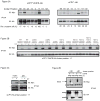Recognition of an ERAD-L substrate analyzed by site-specific in vivo photocrosslinking
- PMID: 21486563
- PMCID: PMC3109430
- DOI: 10.1016/j.febslet.2011.04.009
Recognition of an ERAD-L substrate analyzed by site-specific in vivo photocrosslinking
Abstract
Misfolded, luminal endoplasmic reticulum (ER) proteins must be recognized before being degraded by a process called ERAD-L. Using site-specific photocrosslinking in Saccharomyces cerevisiae, we tested luminal interactions of a glycosylated ERAD-L substrate with potential recognition components. Major interactions were observed with Hrd3p. These are independent of the glycan and of other ERAD components, and can occur throughout the length of the unfolded substrate. The lectin Yos9p only interacts with a polypeptide segment distant from the degradation signal. Hrd3p may thus be the first substrate-recognizing component. Der1p appears to have a role in a pathway that is parallel to that involving Hrd3p.
Copyright © 2011 Federation of European Biochemical Societies. All rights reserved.
Figures





Similar articles
-
Endoplasmic Reticulum-Associated Protein Degradation.Cold Spring Harb Perspect Biol. 2022 Dec 1;14(12):a041247. doi: 10.1101/cshperspect.a041247. Cold Spring Harb Perspect Biol. 2022. PMID: 35940909 Free PMC article. Review.
-
Retrotranslocation of a misfolded luminal ER protein by the ubiquitin-ligase Hrd1p.Cell. 2010 Nov 12;143(4):579-91. doi: 10.1016/j.cell.2010.10.028. Cell. 2010. PMID: 21074049 Free PMC article.
-
A complex of Yos9p and the HRD ligase integrates endoplasmic reticulum quality control into the degradation machinery.Nat Cell Biol. 2006 Aug;8(8):849-54. doi: 10.1038/ncb1445. Epub 2006 Jul 16. Nat Cell Biol. 2006. PMID: 16845381
-
Distinct ubiquitin-ligase complexes define convergent pathways for the degradation of ER proteins.Cell. 2006 Jul 28;126(2):361-73. doi: 10.1016/j.cell.2006.05.043. Cell. 2006. PMID: 16873066
-
The evolving role of ubiquitin modification in endoplasmic reticulum-associated degradation.Biochem J. 2017 Feb 15;474(4):445-469. doi: 10.1042/BCJ20160582. Biochem J. 2017. PMID: 28159894 Free PMC article. Review.
Cited by
-
PDI reductase acts on Akita mutant proinsulin to initiate retrotranslocation along the Hrd1/Sel1L-p97 axis.Mol Biol Cell. 2015 Oct 1;26(19):3413-23. doi: 10.1091/mbc.E15-01-0034. Epub 2015 Aug 12. Mol Biol Cell. 2015. PMID: 26269577 Free PMC article.
-
Yeast derlin Dfm1 employs a chaperone-like function to resolve misfolded membrane protein stress.PLoS Biol. 2023 Jan 23;21(1):e3001950. doi: 10.1371/journal.pbio.3001950. eCollection 2023 Jan. PLoS Biol. 2023. PMID: 36689475 Free PMC article.
-
Quality control: ER-associated degradation: protein quality control and beyond.J Cell Biol. 2014 Mar 17;204(6):869-79. doi: 10.1083/jcb.201312042. J Cell Biol. 2014. PMID: 24637321 Free PMC article. Review.
-
Disposing of misfolded ER proteins: A troubled substrate's way out of the ER.Mol Cell Endocrinol. 2020 Jan 15;500:110630. doi: 10.1016/j.mce.2019.110630. Epub 2019 Oct 24. Mol Cell Endocrinol. 2020. PMID: 31669350 Free PMC article. Review.
-
Endoplasmic Reticulum-Associated Protein Degradation.Cold Spring Harb Perspect Biol. 2022 Dec 1;14(12):a041247. doi: 10.1101/cshperspect.a041247. Cold Spring Harb Perspect Biol. 2022. PMID: 35940909 Free PMC article. Review.
References
-
- Bagola K, Mehnert M, Jarosch E, Sommer T. Protein dislocation from the ER. Biochim Biophys Acta. 2011:925–936. - PubMed
-
- Xie W, Ng DTW. ERAD substrate recognition in budding yeast. Semin Cell Dev Biol. 2010:533–539. - PubMed
-
- Carvalho P, Goder V, Rapoport TA. Distinct ubiquitin-ligase complexes define convergent pathways for the degradation of ER proteins. Cell. 2006:361–373. - PubMed
-
- Huyer G, Piluek WF, Fansler Z, Kreft SG, Hochstrasser M, Brodsky JL, Michaelis S. Distinct machinery is required in Saccharomyces cerevisiae for the endoplasmic reticulum-associated degradation of a multispanning membrane protein and a soluble luminal protein. J Biol Chem. 2004:38369–38378. - PubMed
Publication types
MeSH terms
Substances
Grants and funding
LinkOut - more resources
Full Text Sources
Molecular Biology Databases

